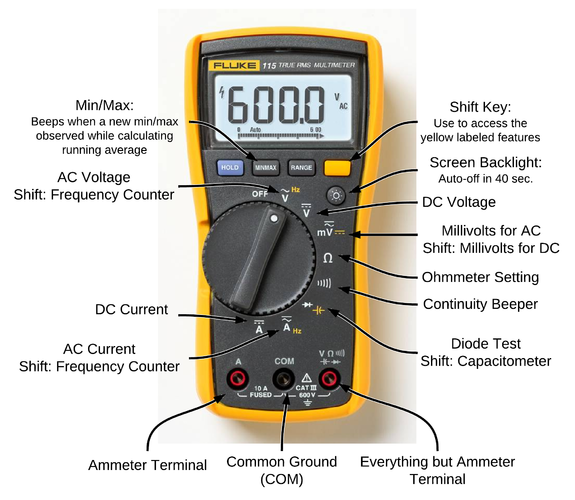Decoding the Ampere: Understanding the Current Symbol on Your Multimeter
Ever glanced at your multimeter and wondered about that squiggly line, the ampere symbol? It's more than just a mark; it's the gateway to understanding the flow of electricity. This seemingly simple symbol represents the fundamental unit of electrical current, the ampere, and mastering its meaning unlocks the power of your multimeter.
Measuring electrical current is crucial in various applications, from troubleshooting household circuits to designing complex electronic systems. Knowing how to interpret the ampere symbol and utilize the current measurement function on your multimeter is essential for safe and effective electrical work. This comprehensive guide will demystify the current symbol, providing you with the knowledge and practical tips to confidently measure electrical flow.
The current setting on a multimeter, denoted by the letter "A," sometimes accompanied by a straight or wavy line representing direct current (DC) or alternating current (AC) respectively, allows you to quantify the flow of electrical charge. Think of it like measuring the flow of water in a pipe. The more water flowing, the higher the current. Similarly, the greater the flow of electrons, the higher the amperage. This fundamental understanding is key to diagnosing electrical issues and ensuring proper circuit functionality.
Understanding the current symbol is just the first step. You also need to know how to correctly connect your multimeter to the circuit for accurate readings. Incorrect connection can not only lead to faulty measurements but can also pose safety risks. We'll delve into the practical aspects of measuring current, ensuring you get reliable results every time.
Before diving into the practicalities, let’s trace back the origins of this important symbol. The ampere, named after French physicist André-Marie Ampère, is a fundamental unit in the International System of Units (SI). Its symbol, often represented as "A," is universally recognized, providing a common language for electricians, engineers, and hobbyists worldwide. The standardization of this symbol is critical for clear communication and collaboration in electrical work.
The importance of the ampere symbol lies in its ability to quickly and efficiently communicate the type of measurement being taken. Imagine a world without this standardized symbol – confusion and miscommunication would reign. The ampere symbol allows for clear labeling on multimeters and circuit diagrams, ensuring everyone is on the same page.
A simple example: you’re trying to determine why your lamp isn't working. By measuring the current flowing to the lamp with your multimeter set to the "A" setting, you can quickly identify if there’s a break in the circuit or another issue.
One benefit of recognizing the current symbol is the ability to quickly and accurately select the correct measurement setting on your multimeter. This saves valuable time and prevents potential damage to the meter or the circuit being tested.
Another benefit is enhanced safety. By understanding the current symbol, you can avoid accidentally measuring voltage while the multimeter is in current mode, which can damage the meter.
Finally, a strong grasp of the current symbol enables effective troubleshooting. You can pinpoint electrical problems, whether it's a short circuit or a faulty component, by accurately measuring the current flow in different parts of a circuit.
To measure current, first turn off the power to the circuit. Then, set your multimeter to the appropriate DC or AC current range based on your expected current. Disconnect the circuit at the point where you want to measure the current. Connect the multimeter in series (in line with) the circuit, ensuring the current flows through the meter. Turn the power back on and observe the reading.
Advantages and Disadvantages of Standardized Current Measurement
| Advantages | Disadvantages |
|---|---|
| Clear communication | Potential for misinterpretation if not properly understood |
| Universal understanding | Requires calibration and proper usage of multimeter |
Best Practices: 1. Always de-energize the circuit before connecting the multimeter. 2. Select the correct current range. 3. Connect the multimeter in series. 4. Never measure current in parallel with a voltage source. 5. Observe proper safety precautions.
Real-world Examples: 1. Checking the current draw of a motor. 2. Diagnosing a blown fuse. 3. Measuring the current consumed by a light bulb. 4. Testing the output of a power supply. 5. Verifying the current rating of a circuit breaker.
Challenges and Solutions: 1. Overloading the multimeter – Solution: choose a higher current range. 2. Difficulty accessing the circuit – Solution: use test leads with clips. 3. Fluctuating readings – Solution: check for loose connections.
FAQ: 1. What does the 'A' symbol represent on a multimeter? Answer: Amperes, the unit of current. 2. What is the difference between AC and DC current? Answer: AC alternates direction while DC flows in one direction.
Tips and tricks: Always double-check your connections. Start with a higher current range and work your way down. Use high-quality test leads for accurate readings.
In conclusion, understanding the current symbol on your multimeter is paramount for anyone working with electricity. From basic troubleshooting to complex circuit analysis, the ability to accurately measure current is an essential skill. This knowledge empowers you to diagnose electrical faults, ensure circuit functionality, and work safely with electrical systems. Mastering the meaning and application of the current symbol is not just about reading a number on a screen; it's about gaining a deeper understanding of the flow of electricity and its practical implications. By following the best practices outlined in this guide, you can confidently use your multimeter to measure current, enhance your understanding of electrical circuits, and contribute to safer and more effective electrical work. Don't underestimate the power of this small symbol – it’s the key to unlocking a world of electrical knowledge.
Unlocking financial flexibility exploring top no deposit credit card options
Boost your rides bass a guide to car subwoofer wiring
Unlocking hopkinsville your guide to finding the perfect house rental













